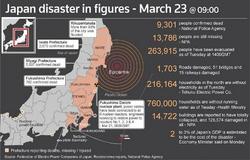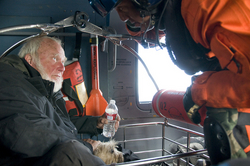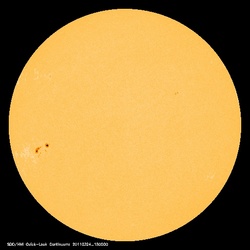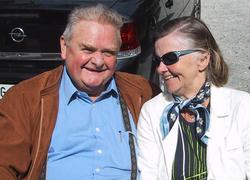 March 24, 2011 John E. Ross, KD8IDJ, Editor
| |||||||||
+ Public Service: Radio Amateurs in Japan Still Providing Communications Support
Amateur Radio operators became involved in the rescue effort soon after the March 11 8.9 earthquake and devastating tsunami that hit northern Japan, and that effort continues nearly two weeks later. "In the early stage following the earthquake and tsunami, several radio amateurs were able to activate their stations with car batteries or small engine generators, despite the electric power outages," IARU Region 3 Secretary Ken Yamamoto, JA1CJP, told the ARRL. "They transmitted rescue requests and information on the disaster situation -- including refugee centers and their needs -- and the availability of basic infrastructures, such as electricity, water and gas supplies." After the earthquake and tsunami, there was no electricity, water or gas service in many of the affected areas.
In his report to the ARRL, Yamamoto said that the Japan Amateur Radio League (JARL) activated JA1RL -- its headquarters station in Tokyo -- soon after the earthquake. With the help of many other amateurs, it also activated its regional headquarters station JA3RL in Osaka to communicate with the amateurs in the damaged areas, including its Tohoku headquarters station JA7RL in Sendai. "The communications were mostly on the 7 MHz band in daytime and the 3.5 MHz band at night," Yamamoto explained. "Short range communications were also made on the 144 and 430 MHz bands. The information gathered through Amateur Radio communications was reported to the rescue and disaster relief organizations for their appropriate deployment. Some other amateurs accepted health-and-welfare inquiries from the [impacted] areas and they posted the information on the Internet." Read more here. + Public Service: Amateurs Assist with Ocean Rescue
At 10:04 AM PDT on March 21, Rex Weinheimer, KC5AGO, of Stonewall, Texas -- a member of the Maritime Mobile Service Net (MMSN) -- heard and responded to a "weak and broken MAYDAY call." The call was from the sailing vessel Gloria Jean, a 30 foot sailboat that was in the Pacific Ocean about 120 miles west of Ensenada, Mexico. Weinheimer heard the distress call on 14.300 MHz, a frequency monitored by the MMSN. MMSN Net Controller Lee Langford, KG4DZN, told the ARRL that through the combined efforts of several net stations, the net was able to ascertain the situation and the position of the stricken vessel. MMSN operators contacted both the US and Mexican Coast Guards and both services deployed assets to the scene. The US Coast Guard dispatched an MH-60 Jayhawk helicopter from San Diego and a C-130 Hercules plane from Sacramento. According to the USCG, the Gloria Jean had no propulsion, food, water or safety equipment. Read more here. + FCC News: FCC Seeking Comments on ARRL Petition Regarding TDMA
Earlier this month, the ARRL filed a Petition for Rulemaking and a Request for Temporary Waiver with the FCC, seeking authorization of the use of single-time-slot Time Division Multiple Access (TDMA) emissions in the amateur bands at and above 50 MHz, wherever multiple-time-slot TDMA is authorized. The FCC has designated the Petition as RM-11625 and is soliciting comments on it. Comments may be filed electronically and will be accepted until April 22 . Read more here. ARRL Recognizes: Nominations for ARRL Awards Now Open Each year, the ARRL Board of Directors has the opportunity to select recipients for a number of awards in various categories that honor Amateur Radio operators. The nomination period is now open for those ARRL awards that recognize educational and technological pursuits in Amateur Radio. There are also awards to honor a young Amateur Radio operator and an outstanding ARRL Section Manager. Read more here. + On the Air: NIST to Conduct Time and Frequency User Survey
The National Institute of Standards and Technology's (NIST) Time and Frequency Division is conducting a survey to learn more about its users, seeking to determine how the agency can make its services more useful in the future. NIST services include WWV, WWVH and WWVB, which provide reference time and frequency signals via radio. The NIST also provides the Internet Time Service -- which provides accurate time synchronization to computer systems -- and several other services to offer accurate time information via telephone or web pages. Radio amateurs are encouraged to complete the survey. Read more here. Solar Update
Tad "The Earth turns, the Sun burns, but I die without you" Cook, K7RA, reports: For the second week in a row, all solar indicators were lower. The average daily sunspot numbers declined more than 28 points from the week before to 40.9, while the average daily solar flux was off more than 18 points to 94.8. But looking at solar images from the STEREO mission, we can see a great deal of activity about to rotate toward us over the Sun's eastern horizon. The whole "back" side of our Sun looks very busy. The NOAA forecast for March 23 for the planetary A index and solar flux still is not available, but the March 22 forecast sees solar flux for March 24-31 at 110, 115, 120, 120, 120, 125, 130 and 135. The planetary A index for the same period is predicted at 8 for March 24-25, 5 on March 26-27 and 8 on March 28-31. This indicates improving HF propagation for the near term, with geomagnetic indicators slightly unsettled, compared to recent quiet conditions. NASA has a video explaining the very low sunspot activity over the past few years. Look for more information on the ARRL website on Friday, March 25. For more information concerning radio propagation, visit the ARRL Technical Information Service Propagation page. This week's "Tad Cookism" is brought to you by the song Without You from the musical Rent. + Silent Key: Thormod "Tom" Bøe, LA7OF (SK)
Thormod "Tom" Bøe, LA7OF, of Horten, Norway, passed away on Monday, March 21. He was 71. Bøe was President of the Norsk Radio Relae Liga, Norway's IARU Member-Society. Bøe actively worked for the Amateur Radio cause throughout his adult life in both a private and professional capacity. For many years, he worked on spectrum management matters with the Norwegian administration, was extremely active in CEPT and ITU forums and served as Director of the European Radiocommunications Office in Copenhagen from 1998-2006. ARRL Chief Executive Officer David Sumner, K1ZZ, remembered Bøe fondly: "Tom was the spokesman for Norway in Committee 5, which was responsible for all frequency allocations -- and I do mean all, as the entire radio spectrum was under review at WARC-79. Norway was an outstanding supporter of Amateur Radio at the conference, and Tom was recognized as the 'most valuable delegate' by the IARU team." Read more here. + ARES® E-Letter Now Available in Audio Form
The ARES® E-Letter is now available in audio format. Edited for audio by Al Brown, KZ3AB, the ARES® E-Letter is voiced by Tony Riggs, W1FHN. Brown was licensed in 1966. He was a member of the White House Press Corps before retiring from the International Broadcasting Bureau/Voice of America (IBB/VOA). Licensed since 1955, Riggs has worked in both the commercial and public broadcasting venues. He retired after 21 years as a staff announcer and news anchor with the VOA. With more than 35,000 subscribers, the ARES® E-Letter is written by Rick Palm, K1CE and is published each month. Click here to subscribe to the ARES® E-Letter. This Week on the Radio This week:
Next week:
All dates, unless otherwise stated, are UTC. See the ARRL Contest Branch page, the ARRL Contest Update and the WA7BNM Contest Calendar for more info. Looking for a Special Event station? Be sure to check out the ARRL Special Event Stations Web page. Upcoming ARRL Section, State and Division Conventions and Events
To find a convention or hamfest near you, click here. ARRL -- Your One-Stop Resource for Amateur Radio News and Information
Click here to advertise in this newsletter. | |||||||||















